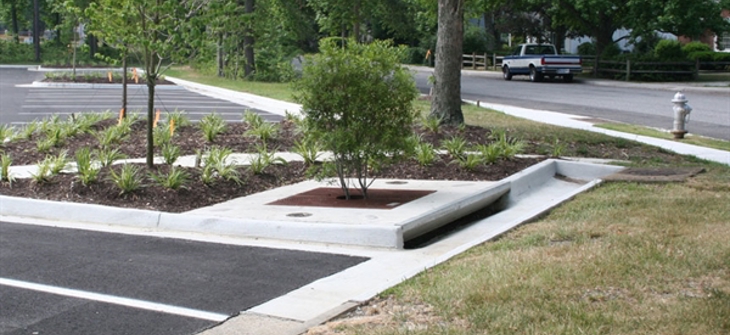
What About Plants?
One could argue that plants are the most essential part of biofiltration systems such as bioretention, high performance biofilters, and rain gardens. However, plant design presents a unique challenge for system designers. What types of plants should be selected? Will they work well in the system? Will they be aesthetically pleasing? Designing a functional biofiltration system requires expertise from different fields of knowledge. Civil engineers typically don’t have much of a background in horticulture and landscaping. Likewise, few landscape architects are fluent in the hydraulic design parameters that must be considered when designing biofiltration systems.
A biofiltration system is first and foremost a stormwater management practice. Biofiltration media is designed to provide and maintain a certain hydraulic conductivity as well as provide treatment of TSS, nutrients, metals, and other pollutants. Ensuring that the hydraulic properties of the system are sustained requires care in both installation and routine maintenance to ensure long term performance. Another major driver for the use of biofiltration is aesthetics. Vegetated systems full of ornamental grasses, shrubs, and trees can increase the visual appeal of a site. However, there is a fine line between long-term system function and aesthetics. It is possible to manage both, but certain parameters should be evaluated.
1. Plant Species
Vegetation should be selected that is capable of long-term survival in a biofiltration system environment. Consider the fact that these systems are designed with highly permeable media (in many cases an order of magnitude more permeable than native soils), with lower organic content, and stormwater as the main source of water. Therefore, plant species selected for use in biofiltration must be hardy; they should be drought tolerant but also able to withstand occasional flooding, adaptable to well-drained soils, and not easily damaged by chemicals typically found in stormwater (metals, salts, oils, etc). Additionally, the United States Department of Agriculture provides Plant Hardiness Zone Maps for selecting plants most likely to survive locally based on average annual winter temperatures.
Plant species with fibrous root systems are ideal. Fibrous roots grow horizontally through the media and are an important mechanism for maintaining media porosity and hydraulic conductivity.
2. Plant Spacing
In traditional landscape design, plants are routinely spaced by the plant spread (mature diameter), or possibly slightly less. When matured, these plants will grow together forming a cohesive landscaped area. However, the primary focus of traditional landscaping is aesthetics. Remember, the primary focus of biofiltration is stormwater management. We cannot manage stormwater without maintenance, which involves the removal of the degraded mulch layer and pollutants. This requires access. Imagine the difficulty in maintaining a five year old system where the plants have completely grown together. This doesn’t mean a barren “sea of mulch” with a couple shrubs is the goal, but designing for maintenance is essential. Grouping plants is acceptable provided that a maintenance pathway is provided between the groupings. Mixing sizes, such as larger trees with smaller shrubs under the edges of the canopy can also help. Plants with spreading growth habits such as certain grasses and vines that can overtake the entire biofiltration area should be avoided.
3. Plant Size
Plant size is an important consideration when installing biofiltration systems. Very small and very large plants can be problematic in new systems. Plants provided in containers less than 1 gallon (such as flats and plugs) are typically much more fragile than more mature plants. These young plants can easily be covered with mulch, trampled, knocked over, or pulled out during storms by incoming debris or during the first routine maintenance.
On the other hand, very large plants can compromise system function and aesthetics. Large plants (greater than 15 gallon) are usually available in box or ball and burlap. Not only do they frequently require special equipment for off-loading, but their root balls are so large that significant amounts of biofiltration media must be removed to allow their installation. Additionally, in most cases, clayey native soils make up the root balls, which further restricts flow through the media and can even contaminate the remaining media. Finally, box or ball and burlap plants are also generally more susceptible to transplant shock since a portion of the root system is removed when the plant is packaged. At times roots are further trimmed to meet media depth plant requirements during installation. Container grown plants in the 1-15 gallon size have the entire root system intact and are ideal for biofiltration systems.
While plant selection and landscape design for biofiltration systems can be more challenging, following the recommendations above should provide not only an aesthetic biofiltration solution, but also one that will function long-term.
